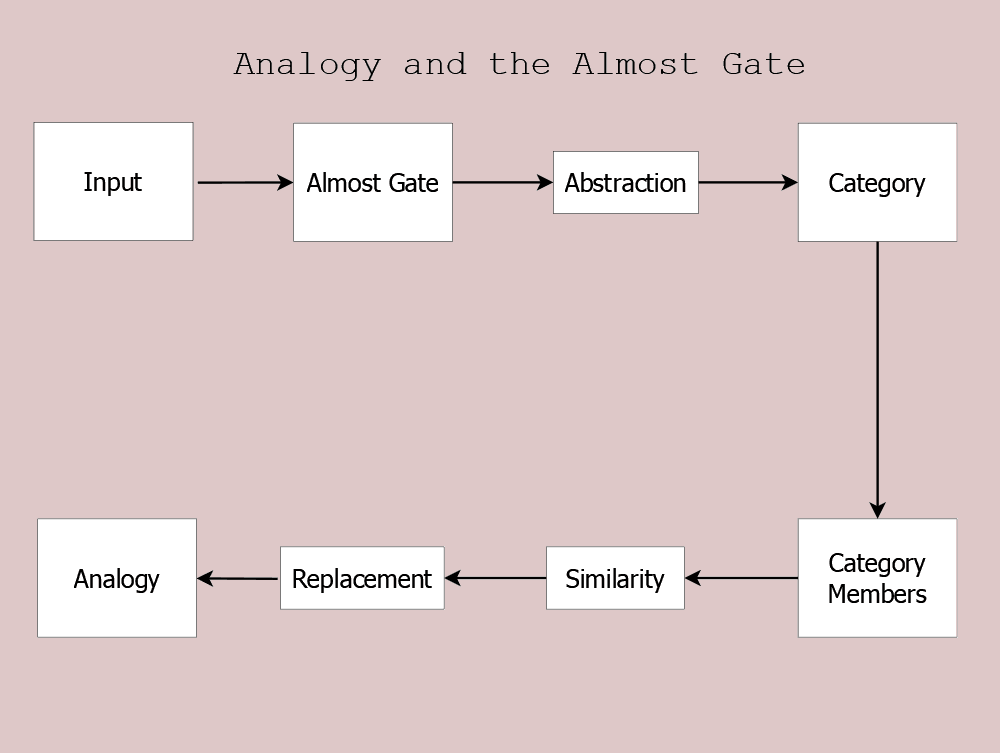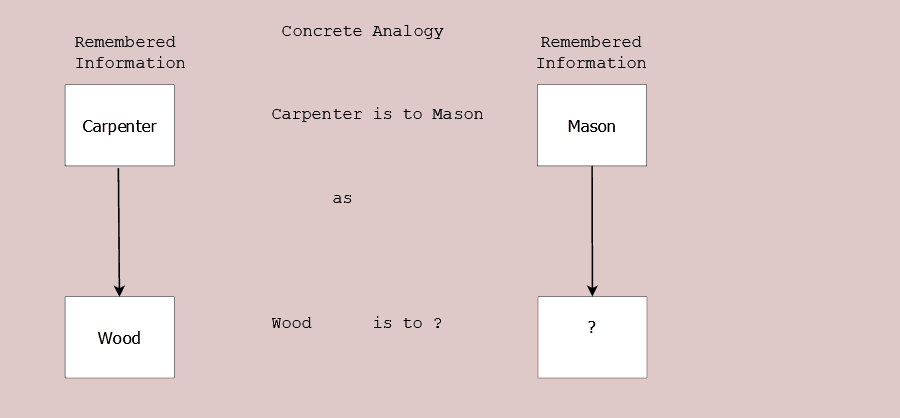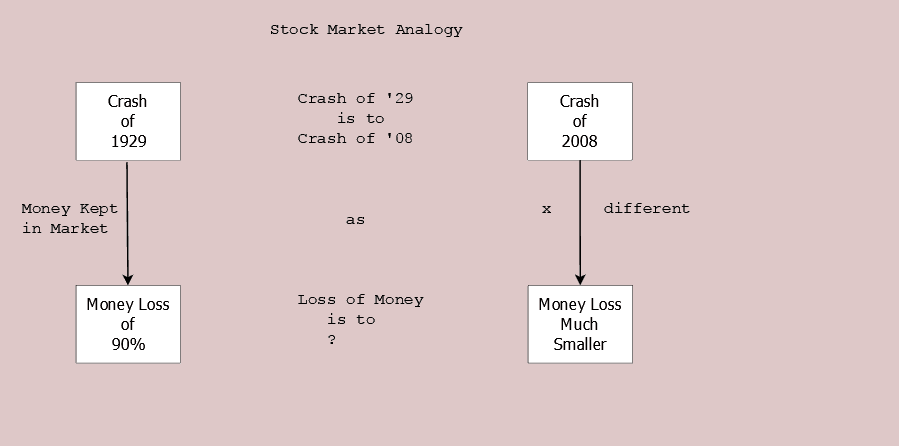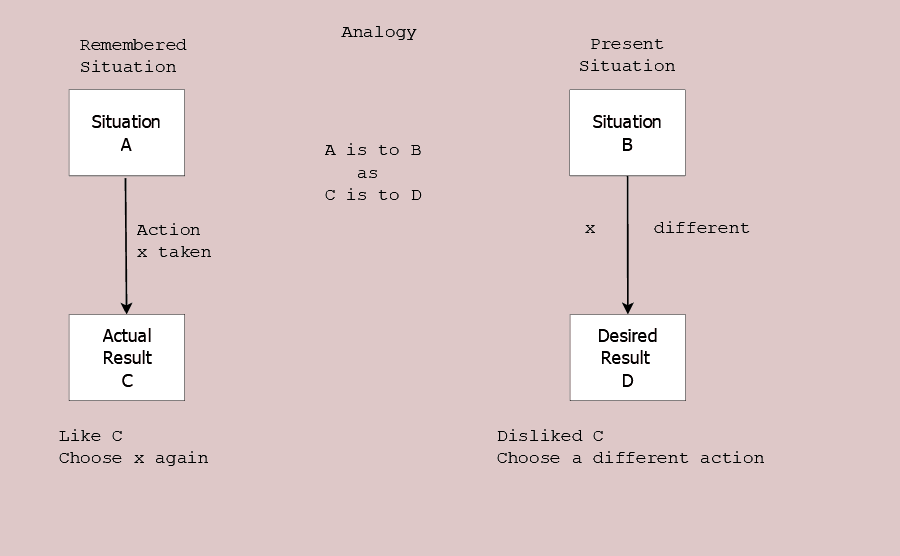Induction is often handily described as reasoning from the specific to the general. We observe night is followed by day. By induction, we conclude when this night ends, day will follow.
How does Mental Construction explain induction’s operation?
Induction Operation
- Abstraction. The Almost Gate automatically eliminates details above the threshold, yielding a common result. Almost Gate post explaining how it arises.
- Categorization. Hebb’s Law explains that repeated experiences strengthen synaptic connections between firing neurons. Hebb’s Law explains both categorization into unnamed patterns and named patterns. Unnamed patterns are patterns you note but that do not have names (or names you know).
- Abstraction and categorization occur at each stop of the concept elevator, the movement of patterns from senses and from memory towards the executive areas of the prefrontal lobes.
- A behavioral choice is selected from a category or cluster. The choice becomes more specific as it approach expression, when it becomes a concrete behavioral expressions.
Induction operation relies on similarity of patterns which, across abstraction levels, supports association between patterns. A typical induction occurs when one compares the present situation with a past situation and, upon finding enough similarities, decides that the outcome of the current situation is likely to be the same as the outcome of the past situation.
Aristotle in De Poetica captures the essence of induction in his final clause lauding metaphor.
The greatest thing by far is to be a master of metaphor. It is the one thing that cannot be learned from others; and it is also a sign of genius, since a good metaphor implies an intuitive perception of the similarity in dissimilars.
The perception of the similarity in dissimilars. That is what the Almost Gate yields when a current input surmounts it, leading to same downstream action as did a previous input which also surmounted the Almost Gate. The two inputs where similar yet they are dissimilar (distinct). If an individual has a high Almost Gate, the two input must both be very similar to have topped the barrier, yet if another individual has a low Almost Gate, the two inputs need less similarity to toppled over the barrier.
How close the association must be? How many features in common must exist for a person to have confidence in the conclusion? The significance of fidelity transmission was broached in Neural Cascade. Completely relying on induction permits false conclusions. An induction conclusion is not guaranteed to be true, even when its starting facts are.
Figure 20.1 shows the general flow of induction in Mental Construction. Without effort, without conscious direction, our brain examines the current environment for patterns similar to those we came across in our past and to those in our learned knowledge. It’s automatic. This base level begins before the level of consciousness, prior to words. For simplicity of discussion, the winning single neuron and neural threshold will be used, although layers of neurons are involved in processing input.
- Input. The originating source. Sensory data or processed data that is passed forward. At most, 0.1% of cortical neurons contact directly with sensory information.
- Almost Gate. When the sum of the dendritic electric potentials meets or exceeds the neural threshold, the axon fires completely.
- Abstraction. A set of different inputs have the capability to cause the neuron to fire, that detail is lost when the Almost Gate is bridged.
- Category. The commonality of the abstraction exists as the organizing feature of the input into a category.
- Category Members. Our learning and memory holds other members in each category. Given multiple levels of abstractions, all features are not necessarily identical in all members of the category.
- Similarity. Remembered instances of the category run parallel through a copy of the same path as the input data feed, bringing over its unique overtones (features above the shared abstraction).
- Replacement. Any remembered instance that has enough features in common can substitute for the original input.
- Analogy. The substitution with its unique antecedents can offer new perspectives on the original situation.
Patterns
At its core, a pattern is a non-verbal method of describing the world. Many patterns earn labels or names in our conscious mind, but they all start as an arrangement of inputs with no names. Patterns are produced in both cortical hemispheres, but the named patterns dominant on the hemisphere which generates speech. It’s easiest to think of a pattern at its origin, a portion of a sensory mode, like a visual snapshot, a sound that we hear but don’t name, or a taste that we crave but can’t describe. Patterns are not just snapshots, but personal encodings.
Patterns can also be sequences of actions that are meaningful to us. Every time that situation occurs, a minute later another thing happens. If one does this, then that follows. Many such sequences have names. Many don’t. The number of named sequences (relationships) you know affect the side of the brain that dominates in processing the information.
Patterns can capture more details than words. Consider a new mustache on your pal, as an example. His verbal name remains the same, but you still recognize him. His pattern is enlarged and more fluid than his name.
More detail is not always superior. Consider Figure 20.2, a painting by William Holman Hunt, with extreme detail throughout the image. The extraneous detail deflects from the attention that should be on the Christ figure.
Patterns and words vie to describe our internal world as they travel along the corpus callosum. This pattern-word matching occurs periodically as they travel their concept elevator toward the frontal lobe.
Analogy
Analogies have two significant characteristics that identify them.
- They draw a comparison in order to show a similarity in some respect.
-
They imply an inference that if things agree in some respects, they probably agree in other ways.
The general form of an analogy has been known since ancient days. A is to B as C is to D. That’s often written A:B :: C:D.
Let’s start with a simple analog, using A is Soap, B is Wash. C is Broom, and D is Sweep
- Soap is to Wash a Broom is to Sweep. We use soap to wash and we use a broom to sweep
Analogies are defined by similarities, not exact matches. Above, instead of the last term Sweep, a final term of Clean also fits. We use soap to clean our skin and we use a broom to clean a floor. An important characteristic of analogies is there exists more than one fourth element that can make sense. This becomes very important when we make inferences based on an analogy.
In Surfaces and Essences: Analogy as the Fuel and Fire of Thinking, Hofstadter and Sander gave us an entire book on analogies, but their interest was psychological use(p 29), not origin. They describe observed analogies. They do not attempt to explain in what manner analogies arise. Mental Construction looks into analogy’s neurological origination.Analogy is the natural operation due to our neural brain Detecting associations between raw concepts is easy. It does not take effort when you know the features of the concepts. However, many analogies depend on knowledge to deliver the similarities required for an analogy to be recognized. Often the features in common are learned.
Consider the relationship in Figure 20.3. The question mark indicates an analogical conclusion that you might need to make. Perhaps on a test, but almost perhaps in understanding a comment from a friend. A Carpenter is to a Mason as Wood is to ?.
If you know the meaning of the words, it’s not hard to understand that D is stone. A carpenter works with wood. A mason works with stone.
Analogies, even with this uncluttered form can be quite difficult. Consider Land is to Water as Arable is to ? or Othello is to MacBeth as Jealousy is to ? These analogies require background knowledge, which you may not have. This shows your knowledge controls which analogies occur to you. The more knowledge you have—whether gained by personal experience, observation of friends, discussions in classrooms or reports in media—the more analogies will occur to you.
Stock Market
Let’s consider an analogy that people based actions on, the stock market in 2008 (Figure 20.4). This is not a discussion of the wisdom of a particular choice, but a consideration of what the analogy was and why some people saw it and other people did not. A feature has been added to the analogy, an action can be performed before the result is seen. In 2008, a significant collapse of stock prices started. Some people were reminded of the crash started in 1929. Columns were written in business pages recommending that you get your money out of the market, because the Crash of 1929 led to a drop of 90% in stock prices.
The analogy is the Crash of ’29 is to the Crash of ’08 as the Loss of Money after ’29 will be to the Loss of Money after ’08, assuming you do the same thing in ’08 as was done in ’29. Therefore to get a different outcome, take a different action—remove your money out of the market.
Many people moved all their money out of the stock market in ’08 based on concern that the analogy would play out the same way as in the Great Depression.
Yet not everyone believed the stock market analogy between ’29 and ’08. Why? A few reasons.
- The doubters had a higher Almost Gate. They naturally demand a greater number of common features before they see a similarity.
- Some doubters may have more information. For example, knowing that the Bernanke had long insisted timid Federal Reserve Board action aggravated the Crash of ’29 and that he would not sit idly by.if a similar crisis arose.
- In this manner, the information entering into their Almost Gates is different.
- Other doubters have distinct theories of stock market pricing which imply different stock market actions.
The essential point is the analogy is it depends on similarities in the abstract representation of the two crashes.The analogy is not the result of a logical deduction. It is an inductive inference.
General Analogy used in decision-making (Figure 20.5).
Analogy and the Almost Gate
It is a known fact that, if it rains, the grass is wet. So, upon seeing that the grass is wet, a naive person may analogically conclude that it has rained. Of course, someone may have just watered the lawn. It may not have rained. It is possible to make mistakes with analogies. That mistakes are possible is not denied, but it is also true if we didn’t make analogical inferences we would decide hardly anything. Complete information is rarely available.
That brings to mind a contrary question. How can deductive logic arise given that our brain is entirely neural?




